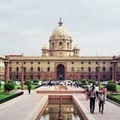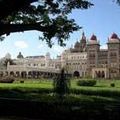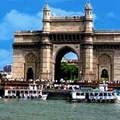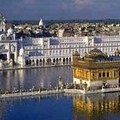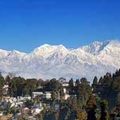Destinations / The Best Cities to Visit in India / Agra - An Architectural Marvel of India
Agra - An Architectural Marvel of India
In the epic poem by the English writer John Milton " Paradise Lost", Agra describes the life of Adam. The protagonist saw the great city of Mughal Agra, which struck him as one of the wonders of God's creation. It is unlikely that this view was an exaggeration: in the 17th century the city was more than Constantinople, London and Paris seemed to be dwarfed by the large population of Agra. A number of magnificent palaces and "fragrant gardens with sweet flowers" stretched on both sides of the river Yamuna. The chronicler of Mughal emperor Abdul Aziz describes the city as "the miracle of the era, the center of trade by land and water, the meeting place of the saints, sages and scientists throughout Asia ... a true beacon for artists, writers and believers."
General Information
With a population of 1,686,000 (2010), Agra is the 19th most populous city in India. It became known as the capital of the Mughal Empire from 1526 to 1658 years and today remains a major tourist destination due to the large number of fine buildings surviving the Mughal era, especially the Taj Mahal, Agra Fort and Fatehpur Sikri, all three are included in the list of the World Heritage.
The Golden Age of the city started during the reign of the Mughals. Initially, Agra was named Akbarabad. Since Akbarabad became the capital of India during the Mughal reign, there went an active construction. The greatest prosperity Akbarabad reached during the reign of Akbar the Great (1556-1605), who built the Agra Fort here, making the city a center of science, art, commerce and religion. Shah Jahan, his name immortalized in the construction of the Taj Mahal , was responsible for the decline of Akbarabad, having decided to move the capital to Shahdzhahanabad, now known under the name of Old Delhi. Although Aurangzeb ordered to return back to the capital, the city remained the capital of the empire a few years and then gradually fell into decay together with the Mughal Empire. Captured by the Marathas, it was renamed in Agra. To date, Agra is a center of heavy and chemical industries in India, which has led to serious environmental problems of the city. Apart from Delhi and Jaipur , Agra is the third city of the "Golden Triangle" - the most popular tourist destinations in India. Tourism accounts for a significant proportion of the city's economy. Agra is a huge, spread out over a wide area and severely polluted industrial city. Few visitors to the city say a good word about this major metropolis of India. For many, it represents the best and the worst aspects of India. The visit will be a difficult challenge for even the most experienced travelers. Corruption and neglect of basic needs and degraded infrastructure are already in Agra: dirty water and open sewers, power outages and gas content of air may come as a shock. Smog and dust - a common phenomenon here, stick to the tourist crowds of traders and rickshaw owners (rickshaw, two-wheeled cart, which a person pulls shafts) near every monument, mosque, temple or palace. In addition, visitors have to deal with large crowds near the main attractions, absurdly high price to pay for the visit. Persistence of street vendors, some individuals seeking to become a tour guide and capitalize on visitors, has no boundaries. Despite these drawbacks, the magnificent attractions of Agra are in order to make a trip here and a trip to India cannot be considered complete without a visit to the Taj Mahal. Agra is situated on the major routes rail links between Delhi - Mumbai (formerly Bombay) and Delhi - Chennai. Located just 200 kilometers south of Delhi, here it is easy to make a day trip on the train back and forth. The train departs from Delhi early in the morning, breakfast is served in the train (included in tariff). About 20 trains from Delhi to Agra transit pass every day. Both cities are notorious for their dense fog in the winter, reducing visibility to almost zero. If you are traveling in late December or early January (season fogs), due to limited visibility trains arrive late.
Attractions of Agra are impossible to be seen in one day, only Taj Mahal deserves more - a quick visit will give the possibility to enjoy the diversity of its species (at the time of sunrise or sunset, changes color), and if you have time, be sure to use the guided tour and visit Fatehpur Sikri and the Red Fort, which takes a few days time.
Agra Attractions
Taj Mahal
Taj Mahal is one of the seven wonders of the world . This is the most famous and durable construction of the Mughal Empire. Designed by a group of architects, the Taj Mahal is probably the most impressive masterpiece of architecture over the past 400 years. The mausoleum was built of white marble in memory of Mumtaz Mahal, one of the favorite wives of Shah Jahan. According to the chronicler Qazwini, "intimacy, deep affection, attention, fueled by his Majesty to Mumtaz exceed thousand times what he felt." Grieving the loss of his beloved wife Mumtaz Mahal, the fifth Mughal emperor Shah Jahan spent his reign in '22, building the world's largest monument to love the Taj Mahal in Agra. Nearly four centuries later, this legacy of Persian architecture is still continuing admiration of contemporaries, so much so that the monument was included in the list of new seven wonders of the world according to international survey. Taj is one of the best preserved, architecturally beautiful tomb in the world, a masterpiece of architecture of Indian Muslims, included in UNESCO World Heritage List. It is instantly recognizable and one of the most photographed buildings in the world.
Agra Fort
At a distance of several kilometers from the Taj Mahal is another famous landmark of the city. Agra Fort (sometimes called the Red Fort) was built on behalf of the Mughal emperor Akbar the Great in 1565, another World Heritage site by UNESCO. Its unattractive exterior hides the inner beauty of the complex. The most famous buildings include Fort Mosque Pearl, halls of public and private meetings, Jahangir Palace, Khas Mahal, Shish Mahal (Mirror Palace) and the Burj Tower Musamman. The total length of the walls on the perimeter is of 2.4 km, twin jagged ramparts of red sandstone from the top alternate with bastions. The ditch width is of 9 meters and a depth of 10 meters around the exterior walls.
Agra Fort is one of the most important fortresses in India . During the reign of Akbar, the fort was mainly used for military purposes during the period of Emperor Shah Jahan served as a court of the emperor.
Some interesting and funny facts:
• Agra Fort has won the Aga Khan Award for Architecture in 2004. In honor of this event India was released on a postage stamp.
• The Fort played a key role in a detective drama of Sherlock Holmes "The Sign of Four." The writer Arthur Conan Doyle describes the fort as follows: "We took refuge in an old fortress Agrskoy. I do not know, gentlemen, have heard any of you about it. This is a very strange building. This I have never seen before, and believe me, I have a lot of strange places seen in my lifetime. "
•The Fort was the site of fierce battles during the Indian Rebellion of 1857. The defeat of the revolt marked the end of the board of British East India Company in India and began a period of direct rule by Great Britain.
• In the second supplement for the video game " The Age of Empires 3 The Asian Dynasties", the Fort is presented as one of the five wonders of the Indian civilization. Mughal emperor Babur
• Humayun, Akbar, Jahangir, Shah Jahan and Aurangzeb lived and ruled the empire from here.
• In the Fort of Agra was the state treasury and mint. It was visited by foreign ambassadors, travelers and the highest dignitaries who left their mark in the history of India.
• The Fort can be more accurately described as a magnificent walled city that actually grief and can be seen in the photographs.
• The Fort combines elements of Hindu and Islamic architecture. Islamic decorations are prohibited, they depict images of living creatures - dragons, elephants and birds, instead of the usual patterns and inscriptions characteristic of Islamic decoration.
Fatehpur Sikri
Mughal Emperor Akbar built Fatehpur Sikri at about 35 km from Agra and moved his capital. It was the first planned city of Mughal and the first city built in the style of Mughal architecture (fusion of Indian, Persian and Islamic architecture.) He served as the capital of the Mughal Empire from 1571 until 1585. The city was abandoned after just 14 years after the construction began. It is believed that the reason for this was the water or rather the impossibility to provide the growing population of the city with water. Today, the buildings of Fatehpur Sikri are a popular tourist attraction in Agra, with 1986 listed as a UNESCO World Heritage Site. The main sights have significant historical value: Buland Darwaza (Great Gate or High), the mosque of Jama Masjid, The Tomb of Salim Chisti, Panch Mahal Palace. Near the historic part of the town is Fatehpur Sikri with a population of about 30,000 people.
The Mausoleum of Itmad ud Daula
The Mausoleum of Itmad ud Daula is located in the city of Agra . The mausoleum of Itmad ud Daula (sometimes called " The Child of the Taj") was built by Empress Noor Jahan for his father Jahangir. The mausoleum is located in a large garden, crossed by canals and walkways. At the corners of the hex rush up the tower, the height is of about thirteen meters. The Mausoleum is small compared with many other tombs of the Mughal era. The walls are inlaid with white marble, semi-precious jewelry of carnelian, jasper, lapis lazuli, onyx and topaz in images of cypress trees and wine bottles or more complex decorations like cut fruit or vases with bouquets. The light penetrates into the interior through thin holes in the white marble in the form of patterns. Many of the relatives of Nur Jahan are buried in the mausoleum. The only asymmetrical element of the complex is the tomb of his father and mother, set next to each other, following the example of Taj Mahal. The main building complex consists of numerous outbuildings and gardens. The tomb, built between 1622 and 1628 is a model of transition from the first phase of the monumental architecture of the Mughals, mostly built of red sandstone with marble decorations, as Humayun's Tomb in New Delhi and Akbar at Sikandra to its second phase, based on white marble, the most elegant implemented in the Taj Mahal .
The tomb of Akbar the Great
The Tomb of Akbar the Great is a well known masterpiece of Mughal architecture. It is situated at a distance of 8 km from the center of the city of Agra. The third ruler of the Mughal Emperor Akbar the Great (1542 - 1605) began its construction around 1600, in accordance with the tradition of Tartary (Tartary - used in Western literature, the term to refer to areas that once were part of the Golden Horde) to begin the construction of the tomb during his lifetime. After the death of the son, Akbar Jahangir completed the construction in 1613. The city of Agra has a number of other interesting historical sites, but these are the most important.
Others The Best Cities to Visit in India .
Others from The Best Cities to Visit in India
You can stay at different hotels and chalets in India, which are available in abundance.
You can even opt for holiday rentals apartments which can be found in all towns.
There are various holiday villas in many cities to promote tourism.
Here, we present the top cities with landmark tourist spots as well.
Geographical position India is a country in South Asia.
India is the 7th place in the hierarchy of countries by area, second only to the number of inhabitants and democracy to most people.
Neighborhood India has a coastline with a length of seven thousand kilometers and the western border with Pakistan, Nepal, China, Bhutan and Bangladesh in the northeast and Mynmar in the east.
In the Indian Ocean, it is adjacent to Sri Lanka, Maldives and Indonesia.
The Relief India has three natural regions: the region of high mountains, Indo-Ganges Plain and the Deccan Plateau.
The region of high mountains in the north and northeast of the country comprises most of the Karakorum Mountains and part of the Himalaya Mountains.
High mountains covered with snow are persistent, there are many glaciers which are strongly fragmented by rivers.
Indo-Ganges is an alluvial plain, low and smooth.
The landscape is formed from the large Indian peninsular Deccan Plateau with sharp edges which are based on coastal plains.
The most important river of India is the Ganges.
Climate The climate of India is tropical monsoon with different shades, depending on the altitude and the available relief.
In the Northeast and in some areas protected from the wind very little precipitation falls on the Deccan Plateau, western slopes of Western Ghat region at the foot of Himalaya receive a large amount of precipitation.
Tourism Home of the Hindu civilization of the valley, the center of trade routes and vast empires, India has played a major role in the human history.
Brahmanism, Hinduism, Sikhism, Buddhism and janismul originated in India, while Islam and Christianity enjoy a rich tradition here.
Colonized as part of the British Empire in the nineteenth century, India gained independence in 1947 as a unified nation after sustained effort made in this direction.
Population, creatures,the geographical and climate system are among the most diverse in the world.
You may also remember that India is the home of pepper.



